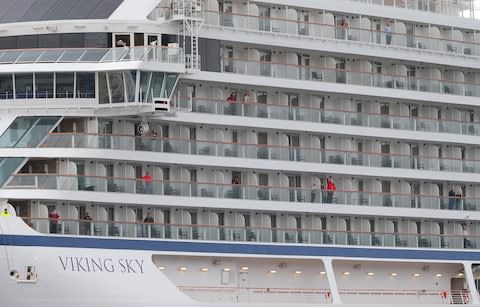What happened with Viking Sky – and is it safe to cruise in extreme conditions?

Who had heard of Hustadvika, in Norway, before a cruise ship sailed into a storm there at the weekend?
Although relatively unknown, the stretch of coast where hundreds of passengers were rescued from Viking Sky – is far from benign. On its website the Norwegian tourism board refers to it as the “wild Hustadvika coast.”
Norway is one of Europe’s most popular cruising destinations. Scores of ships ply its waters, carrying passengers on summer sailings through the scenic fjords and, in the winter, offering them the chance to admire the Northern Lights. Lines including P&O, Saga and Holland America cruise Hustadvika en route from Stavanger to more northerly ports like Trondheim.
Launched in 2017, Viking Sky was sailing from Tromsø in the far north of Norway south to Stavanger when it hit bad weather.
Pål Are Lilleheim, senior advisor information and public relations for the Norwegian Coastal Administration said it is not uncommon to encounter this type of weather in spring. “When special circumstances occur, the NCA send out warnings,” he said. “That does not mean that we close the waters like Hustadvika. The Norwegian Meteorological Institute provides meteorological services. Currents, wind and wave warnings are provided by us.”

This and other information, combined with years of rigorous training, will contribute towards the overall assessment of a given situation. Ultimately it is up to the captain to decide how to handle a challenging situation.
Are Lilleheim said new vessels like Viking Sky are built to handle such conditions. “This situation did not happen due to [bad] weather but due to machine malfunctions, the cause [of which] is now being investigated,” he said.
Cruise industry body CLIA (the Cruise Lines International Association) concurs. “Cruise ships are designed to withstand extreme weather conditions at sea, and, whenever possible, seek to avoid bad weather,” said a spokesperson.

Telegraph Travel cruise expert Jane Archer spends much of the year at sea. “Weather reports now are usually very accurate so the captain must have known a storm was on the cards. Assuming there was a possibility of stormy seas, it would have been better to stay in the previous port until the bad weather passed.
“Passengers get very upset when itineraries change and they miss ports but in this case it would have been hard to argue against it. One of the selling points of a cruise holiday is that ships can avoid bad weather by changing course. In this case, that did not happen so no doubt a lot of questions will be asked about the decisions taken.”
Viking Ocean Cruises said Viking Sky had on board two experienced local Norwegian pilots who were there to advise the captain. It said that the cause of the engine failure is currently being probed, and that until the investigations have been completed it cannot speculate on the cause of the incident.
Norwegian line Hurtigruten has been transporting passengers around Norway’s coast since 1893 and is all too aware of the risks.
Referring to ships that would have passed through Hustadvika at the time the weather was at its worst during the past few days, Rune Thomas, VP global communications for the line said: “Based on our previous experience, and the weather forecast, two Hurtigruten captains decided independently and individually to stay in port.”
We’re waiting for evacuation by helicopter #VikingSky#Maydaypic.twitter.com/rqSYaWGi0k
— Alexus Sheppard ��️�� (@alexus309) March 23, 2019
“We pass Hustadvika 700 times a year. There are a only handful of times a year where the conditions are so extreme that we cannot. Every decision to divert due to weather conditions are made by our highly experienced captains.”
Viking Sky is currently docked in Molde. The line has confirmed there were 25 reported injuries. Ten people remain in hospital.
Chairman of Viking Cruises Torstein Hagen said: “The past few days have been stressful for both guests and crew alike. I would like to personally apologise for what our guests experienced and say how impressed and grateful I am for the efforts of the national rescue services, rescue personnel, local authorities and the people along the Møre coast, and thank them for the concern and generosity they have shown our guests.
“I would also like to express my thanks to the crew on board the Viking Sky for their efforts and dedication.”
Further south, at Norway’s Stad peninsula, plans have been mooted for the world’s first full-scale ship tunnel to be built to protect vessels from one of the most exposed and dangerous areas of the coast of Norway.
The tunnel would be 1.7 kilometres long, 50 metres high (38 metres above the sea level and 12 metres below) and 36 metres wide. It would allow ships of a certain size to navigate more safely through the Stadhavet Sea, reducing the risk of incidents and accidents.
The Norwegian parliament has earmarked around £90m for the proposed Stad Ship Tunnel. “It has not been confirmed but it is part of the budget,” a spokesperson for Innovation Norway told Telegraph Travel. “If there’s money for the project on the national budget for 2020, construction of the tunnel could potentially start in 2022.”
Cruise ship design and bridge navigation equipment is the most advanced it has ever been. In fact, there has never been a safer time to be a cruise passenger at sea. The International Convention for the Safety of Life at Sea (SOLAS), provides comprehensive regulations and standards on safety equipment and procedures for ships. Since the Costa Concordia distaster in 2012 it has been mandatory for all cruise ships to carry out a mandatory safety drill for embarking passengers immediately before, or immediately after, departure from port.


